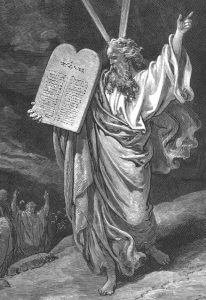 Previously, three periods of time were addressed during which God dealt differently with people. Those periods are the Patriarchal, Mosaic, and Christian. In this article, we examine the Mosaic age in greater detail.
Previously, three periods of time were addressed during which God dealt differently with people. Those periods are the Patriarchal, Mosaic, and Christian. In this article, we examine the Mosaic age in greater detail.
God has always governed men through covenants. These agreements set forth the terms of God’s blessings and the consequences for disobedience. One of the three major covenants is that given to Israel at Mount Sinai. The Law of Moses provided for national, civic, and spiritual conduct. It was a beautiful law that glorified God and taught his people of holiness. Nevertheless, the Law of Moses was never intended to be permanent. It is no longer in effect. We do not live according to its precepts.
Beginnings of the Law of Moses
Israel left Egyptian enslavement in Exodus 12:37. Their journey took them to the Mountain of God, Mount Sinai. There, God gave Moses a series of laws which would govern the Israelites and form the basis of their relationship with him.
This law was intended only for Israel. Observe the words of Scripture at Exodus 20:2: “I am the Lord your God, who brought you out of the Land of Egypt, out of the house of slavery.” Immediately, the Lord delivers the Law of Moses. This short preamble confirms that one people, namely, those God brought out of Egypt, received the law. No Gentile (non-Jewish) people were ever amenable to the Law of Moses. They were subject to the same God but not via the same law. They would remain under the so-called Patriarchal covenant until Acts 10 and Cornelius.
Great miracles attended the giving of the Law of Moses. About three months prior, the Israelites had witnessed stupendous miracles of God through the hand of Moses. A series of plagues against Egypt shattered their bonds. The powerful parting of the Red Sea and destruction of the Egyptian army confirmed that God was with Israel. Now, at Sinai, Moses again stood before the people as a messenger of God to deliver this new law.
Contents of the Law of Moses
The law contained regulations for national life, community life, and spiritual life. At the center of the nation there literally stood the Tabernacle. It was here that God would show his presence and dwell among his people. It was at the Tabernacle that Israel offered sacrifices precisely according to God’s commands. Even the unique clothing of the priests was dictated by Jehovah (Exodus 28).
Modern worship incorrectly includes items of Mosaic worship. A different time and place were appropriate for such items as mechanical instruments of music, incense burning and the elevation of priests (clergy). Many today seem to pick and choose how to worship.
God taught through the Law. Paul writes that the law was a guardian for mankind (Galatians 3:15-29). We learn much about God through his dealings with Israel. We learn of his demand for holiness and is unwavering demand for faithfulness to his laws and commands. We learn that man was never left to his own worship inventions but is carefully guided in every respect.
Temporary nature of the Law of Moses
The law given at Sinai was not permanent and is not normative for Christian life and worship. Isaiah spoke of “latter days” when God would change his law (Isaiah 2:1-5) such that “all nations” would flow into his kingdom (Isaiah 2:2). Paul writes that the law was not sufficient to show the true righteousness of God (Romans 3:21-31). The Hebrew’s writer would argue that the blood of bulls and goats could not take away sin (Hebrews 9:15-23). The reference to bulls and goats points to key elements of Mosaic sacrifice. Paul would write that these ordinances are taken away and nailed to the cross (Ephesians 2:15; Colossians 2:8-15, esp. 14).
Today, the Christians are freed from the Law of Moses. Let us rejoice in Christ and never try to go back to the elements of an old, insufficient law.